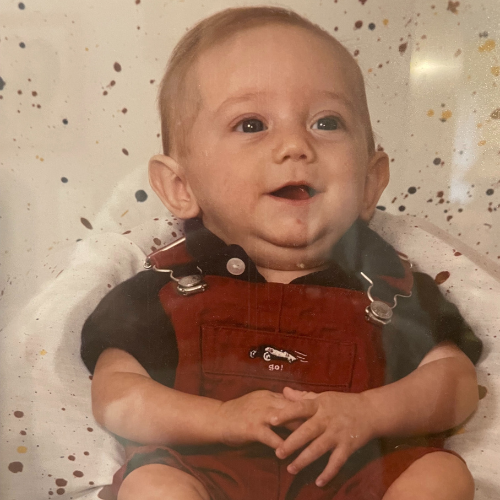DOWNLOAD STATE FACT SHEET AS PDF

In 2020, there were 34,376 live births in Kansas2 There are 34 conditions on the Kansas Newborn Screening Panel3
All babies in the United States are screened for several conditions shortly after birth. Approximately 24-48 hours after a baby is born in the United States, the heel is pricked by a nurse to collect a small blood sample. Afterward, the nurse puts a series of blood drops onto a filter paper to create several “dried blood spots.” Next, the newborn screening card is sent to the state laboratory for analysis. Kansas is not screening for Krabbe Disease.
What is Krabbe Disease?
Krabbe disease (pronounced krab A), is a rare genetic disorder, also known as globoid cell leukodystrophy. In the United States, Krabbe disease has been reported to affect approximately 1 in 100,000 individuals. Infantile Krabbe disease is the most common and severe form causing infants to lose the ability to eat, extreme irritability, inability to sit up, grasp objects, blindness, and seizures. Sadly, infants die within the first 2-3 years of life in states that do not test for Krabbe disease. We invite you to learn more about Understanding Krabbe Disease.
Why Screen for Krabbe Disease?
Krabbe disease is a severe neurodegenerative and rapidly progressing condition requiring immediate treatment for the most severe forms. The medical issues and symptoms of Krabbe disease are very significant and life-impacting. A delayed diagnosis, especially in the most severe forms, equates to palliative and supportive care as the only means of treatment until premature death.
Krabbe Disease Hero: Trevor Leeker

See all our Krabbe Disease Heroes.
Trevor was born on May 14, 1999 – a Mother’s Day gift to Bill and Michelle. They were amazed by his dark hair, big blue eyes, and his alertness. He seemed to be a perfectly healthy little boy with a great deal of strength. Trevor began to lose that strength a few months later, and at his six-month checkup, Michelle expressed her concerns that something seemed to be wrong. The pediatrician told her to stop worrying and brushed off her concerns. She continued to notice that he was losing milestones and wasn’t eating well.
Trevor contracted influenza when he was eight months old, and when they finally got him an appointment the doctor expressed concern that he might have meningitis because he was holding his head back. Michelle reminded him that he had been doing that long before he got sick, but the doctor ignored her concerns a second time. They pushed for a referral to a children’s hospital or university medical center because they believed Trevor had Cerebral Palsy and finally received the referral when Trevor was nine months old. It was then that the pediatrician became concerned and urged the Leekers to see a neurologist because Trevor’s health was deteriorating quickly – words that understandably upset the Leekers.
The neurologist listened closely to what Michelle had observed and ordered a CT scan; that evening, the neurologist called and told them that Trevor needed to have an MRI because of what the CT scan showed. Trevor was admitted to the hospital for further testing on March 21, 2000 and the Leekers had no idea how long he would be there.
Michelle remembers telling Bill that her heart knew they were going to tell them that Trevor was dying. Three days later, her fear would be confirmed. On March 24th, a group of doctors asked them to sit down and began to explain everything the tests had revealed. Michelle stopped them and said, “Are you telling me that my son is dying?” The room fell silent for a moment before the neurologist acknowledged the reality: ten-month-old Trevor had Krabbe Disease and he likely had a year to live.
Trevor loved to ride horses and loved being entertained by his older brother. His parents made sure that he had the best possible life despite the circumstances and he passed away at twenty-one months of age.
Resources
- The Leukodystrophy Newborn Screening Action Network is dedicated to advancing newborn screening for leukodystrophies and lysosomal storage disorders, supporting newly-diagnosed families, and ensuring collaboration between all stakeholders. Learn more at https://ldnbs.org/.
- CDC offers funding and assistance through the Newborn Screening Quality Assurance Program (NSQAP). More information can be found at https://www.cdc.gov/labstandards/nsqap.html.
- Baby’s First Test provides funding opportunities through grants. Learn more at https://www.babysfirsttest.org/newborn-screening/funding-opportunities.
- American Public Health Laboratories NewSTEPS program provides data, technical assistance, and training. Details at https://www.newsteps.org/.
- KrabbeConnect offers patient support services to help families navigate the burden of Krabbe disease. Learn more at https://krabbeconnect.org/.
- Hunter’s Hope Foundation is a non-profit organization committed to giving hope through education, awareness, research, and family care for all leukodystrophies. Learn more at https://www.huntershope.org/.
Citations
- Wenger DA. Krabbe Disease. 2000 Jun 19 [Updated 2011 Mar 31]. In: Pagon RA, Adam MP, Ardinger HH, et al., editors. GeneReviews® [Internet]. Seattle (WA): University of Washington, Seattle; 1993-2017.
- “Fertility Rate: Kansas, 2010-2020.” March of Dimes | PeriStats, https://www.marchofdimes.org/peristats/data?reg=99&top=2&stop=1&lev=1&slev=4&obj=1&sreg=34. Accessed 13 August 2023.
- “Kansas| Baby’s First Test | Newborn Screening | Baby Health.” Babysfirsttest.org, 2015, https://www.babysfirsttest.org/newborn-screening/states/kansas. Accessed 13 August 2023.
All information in this fact sheet is based on data available before August 13, 2023.


